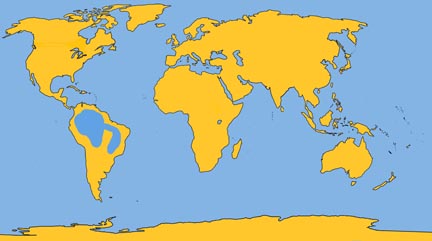Bouto
Family: Iniidae
Genus: Inia
Species: I. geoffrensis (de Blainville, 1817)
The largest of freshwater dolphins, Amazon River dolphins developed unusual features — as have many other animals inhabiting the Amazon River system. As might be expected of a species inhabiting turbid waters, these dolphins’ eyes are very small; however, the animals have keen eyesight. As with all exclusively freshwater dolphins, the beak is unusually long, yet stout; the flippers are very broad rather than streamlined, and are flexible at the axila (armpit). Although the animals reach 9.75 ft. (3 m) in length, they are able to maneuver well in close quarters.
Amazon River dolphins spend a great deal of time in physical contact with one another. They have been observed heaving their bodies out of the water onto mud banks for food, rolling and twisting to return to the water. Amazon tribesmen believe that killing this animal brings very bad luck.
Physical Description: Most dolphins are born with hairs on their beak, many of which disappear early in life. The presence of those hairs that remain is unique among dolphins; apparently they are used while the animal probes the mud for food. The body is large and soft, forming folds when the head is moved. The bulbous forehead is small in proportion to the body. The blowhole is a rectangular slit.
Color: Some animals are pink overall; others are gray dorsally, converging to pink ventrally. The many color variations suggest that color is subject to environmental conditions.
Fins and Flukes: The dorsal area rises from both the posterior and anterior ridges to meet at a point just to the rear of the mid-back region. Here there is a single pointed rise where a dorsal fin would be on most other dolphins. The flippers are very large and well spread. The flukes, often serrated on the trailing edge, are very large and well spread also, with a median notch. The tips are nearly pointed.
Length and Weight: They reach 8.25 to 9.75 ft (2.5 to 3 m) and nearly 200 lb (90 kg). Males are slightly larger than females.
Teeth: There are 24 to 30 large conical teeth on each side of the upper and lower jaws, although the tooth count varies among geographic populations.
Feeding: They feed on turtles, catfish, and other freshwater fish, and crustaceans.
Breathing and Diving: The Amazon River dolphin breathes every 35 to 40 seconds, with a maximum recorded dive of 112 seconds. It’s blow is very noisy and very high, up to 6 ft (1.8 m).
Mating and Breeding: Infants are born between July and September, about 30 in (75 cm) long and weighing just over 2.2 lb (1 kg), after a gestation period believed to be from 9 to 12 months. Sexual maturity in males is reached at about 7 ft (2 m) and in females at 5.5 ft (1.7 m), at an unknown age.
Herding: Observed individually or in groups of up to 3; rarely up to 20 individuals.
Distribution: Amazon River dolphins are found in all main rivers of the Orinoco and Amazon river systems. The northern population inhabits the Orinoco, Atabapo, and Temi rivers, and their tributaries. The central population ranges throughout the Amazon basin and the rivers of Peru and Brazil. The southern population, sometimes called the Bolivian dolphin, also inhabits the Amazon basin and the rivers of Peru.
Migration: No information is available.
Natural History Notes: Ordinarily a very slow-moving animal, the Amazon River dolphin may swim rapidly to breathe or feed, swimming just below the surface, where it breaks in a horizontal position.









